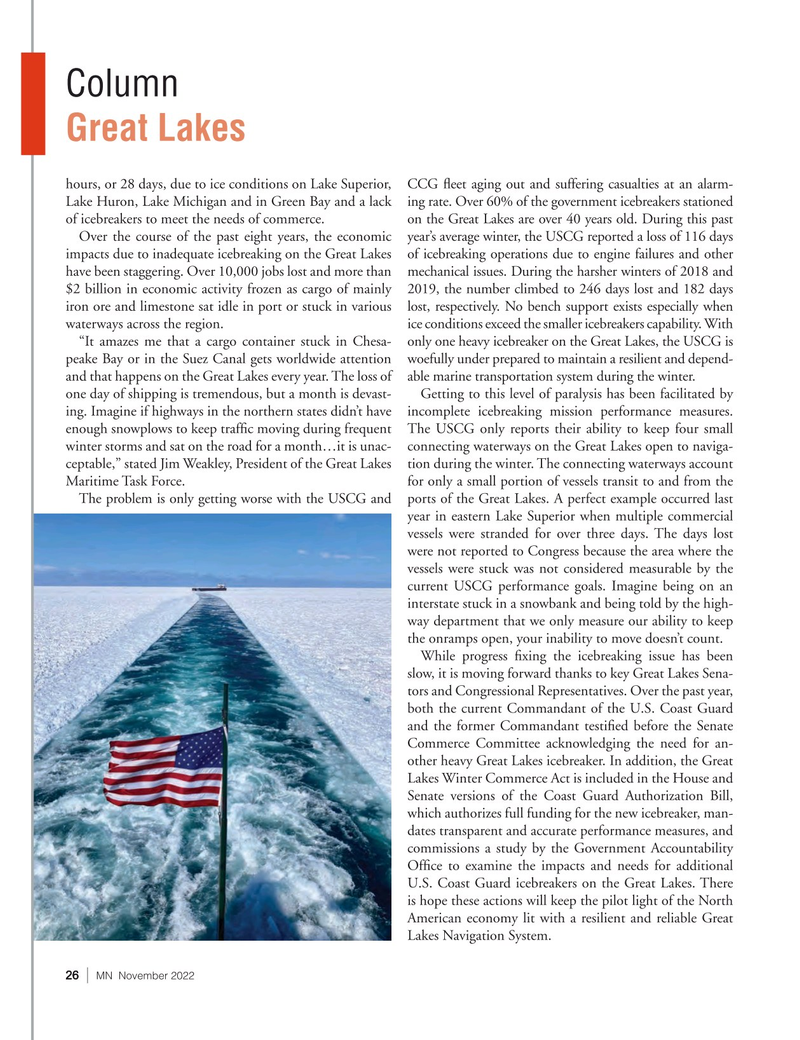
Page 26: of Marine News Magazine (November 2022)
Great Workboats of 2022
Read this page in Pdf, Flash or Html5 edition of November 2022 Marine News Magazine
Column
Great Lakes hours, or 28 days, due to ice conditions on Lake Superior, CCG ? eet aging out and suffering casualties at an alarm-
Lake Huron, Lake Michigan and in Green Bay and a lack ing rate. Over 60% of the government icebreakers stationed of icebreakers to meet the needs of commerce. on the Great Lakes are over 40 years old. During this past
Over the course of the past eight years, the economic year’s average winter, the USCG reported a loss of 116 days impacts due to inadequate icebreaking on the Great Lakes of icebreaking operations due to engine failures and other have been staggering. Over 10,000 jobs lost and more than mechanical issues. During the harsher winters of 2018 and $2 billion in economic activity frozen as cargo of mainly 2019, the number climbed to 246 days lost and 182 days iron ore and limestone sat idle in port or stuck in various lost, respectively. No bench support exists especially when waterways across the region. ice conditions exceed the smaller icebreakers capability. With “It amazes me that a cargo container stuck in Chesa- only one heavy icebreaker on the Great Lakes, the USCG is peake Bay or in the Suez Canal gets worldwide attention woefully under prepared to maintain a resilient and depend- and that happens on the Great Lakes every year. The loss of able marine transportation system during the winter.
one day of shipping is tremendous, but a month is devast- Getting to this level of paralysis has been facilitated by ing. Imagine if highways in the northern states didn’t have incomplete icebreaking mission performance measures. enough snowplows to keep traf? c moving during frequent The USCG only reports their ability to keep four small winter storms and sat on the road for a month…it is unac- connecting waterways on the Great Lakes open to naviga- ceptable,” stated Jim Weakley, President of the Great Lakes tion during the winter. The connecting waterways account
Maritime Task Force. for only a small portion of vessels transit to and from the
The problem is only getting worse with the USCG and ports of the Great Lakes. A perfect example occurred last year in eastern Lake Superior when multiple commercial vessels were stranded for over three days. The days lost were not reported to Congress because the area where the vessels were stuck was not considered measurable by the current USCG performance goals. Imagine being on an interstate stuck in a snowbank and being told by the high- way department that we only measure our ability to keep the onramps open, your inability to move doesn’t count.
While progress ? xing the icebreaking issue has been slow, it is moving forward thanks to key Great Lakes Sena- tors and Congressional Representatives. Over the past year, both the current Commandant of the U.S. Coast Guard and the former Commandant testi? ed before the Senate
Commerce Committee acknowledging the need for an- other heavy Great Lakes icebreaker. In addition, the Great
Lakes Winter Commerce Act is included in the House and
Senate versions of the Coast Guard Authorization Bill, which authorizes full funding for the new icebreaker, man- dates transparent and accurate performance measures, and commissions a study by the Government Accountability
Of? ce to examine the impacts and needs for additional
U.S. Coast Guard icebreakers on the Great Lakes. There is hope these actions will keep the pilot light of the North
American economy lit with a resilient and reliable Great
Lakes Navigation System.
26 | MN November 2022

 25
25

 27
27
